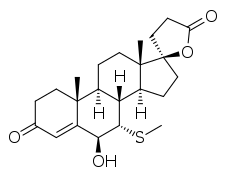6β-Hydroxy-7α-thiomethylspironolactone
6β-Hydroxy-7α-thiomethylspironolactone (6β-OH-7α-TMS) is a steroidal antimineralocorticoid of the spirolactone group and a major active metabolite of spironolactone.[1][2][3] Other important metabolites of spironolactone include 7α-thiospironolactone (7α-TS; SC-24813), 7α-thiomethylspironolactone (7α-TMS; SC-26519), and canrenone (SC-9376).[4][2][1][3]
 | |
| Clinical data | |
|---|---|
| Other names | 6β-OH-7α-TMS; 6β,17α-Dihydroxy-7α-(methylthio)-3-oxo-pregn-4-ene-21-carboxylic acid γ-lactone |
| Drug class | Antimineralocorticoid |
| Identifiers | |
IUPAC name
| |
| CAS Number | |
| PubChem CID | |
| ChemSpider | |
| UNII | |
| Chemical and physical data | |
| Formula | C23H32O4S |
| Molar mass | 404.57 g·mol−1 |
| 3D model (JSmol) | |
SMILES
| |
InChI
| |
Spironolactone is a prodrug with a short terminal half-life of 1.4 hours.[5][6][7] The active metabolites of spironolactone have extended terminal half-lives of 13.8 hours for 7α-TMS, 15.0 hours for 6β-OH-7α-TMS, and 16.5 hours for canrenone, and accordingly, these metabolites are responsible for the therapeutic effects of the drug.[5][6]
| Compound | Cmax (day 1) | Cmax (day 15) | AUC (day 15) | t1/2 |
|---|---|---|---|---|
| Spironolactone | 72 ng/mL (173 nmol/L) | 80 ng/mL (192 nmol/L) | 231 ng•hour/mL (555 nmol•hour/L) | 1.4 hours |
| Canrenone | 155 ng/mL (455 nmol/L) | 181 ng/mL (532 nmol/L) | 2,173 ng•hour/mL (6,382 nmol•hour/L) | 16.5 hours |
| 7α-TMS | 359 ng/mL (924 nmol/L) | 391 ng/mL (1,006 nmol/L) | 2,804 ng•hour/mL (7,216 nmol•hour/L) | 13.8 hours |
| 6β-OH-7α-TMS | 101 ng/mL (250 nmol/L) | 125 ng/mL (309 nmol/L) | 1,727 ng•hour/mL (4,269 nmol•hour/L) | 15.0 hours |
| Sources: See template. | ||||
6β-Hydroxytestosterone, which is analogous to 6β-OH-7α-TMS, has been found to possess virtually no androgenicity.[8]
See also
References
- Yang J, Young MJ (2016). "Mineralocorticoid receptor antagonists-pharmacodynamics and pharmacokinetic differences". Curr Opin Pharmacol. 27: 78–85. doi:10.1016/j.coph.2016.02.005. PMID 26939027.
- Kolkhof P, Bärfacker L (2017). "30 YEARS OF THE MINERALOCORTICOID RECEPTOR: Mineralocorticoid receptor antagonists: 60 years of research and development". J. Endocrinol. 234 (1): T125–T140. doi:10.1530/JOE-16-0600. PMC 5488394. PMID 28634268.
- Doggrell SA, Brown L (2001). "The spironolactone renaissance". Expert Opin Investig Drugs. 10 (5): 943–54. doi:10.1517/13543784.10.5.943. PMID 11322868.
- Parthasarathy HK, MacDonald TM (2007). "Mineralocorticoid receptor antagonists". Curr. Hypertens. Rep. 9 (1): 45–52. doi:10.1007/s11906-007-0009-3. PMID 17362671.
- Sica DA (2005). "Pharmacokinetics and pharmacodynamics of mineralocorticoid blocking agents and their effects on potassium homeostasis". Heart Fail Rev. 10 (1): 23–9. doi:10.1007/s10741-005-2345-1. PMID 15947888.
- Maron BA, Leopold JA (2008). "Mineralocorticoid receptor antagonists and endothelial function". Curr Opin Investig Drugs. 9 (9): 963–9. PMC 2967484. PMID 18729003.
- Oxford Textbook of Medicine: Vol. 1. Oxford University Press. 2003. pp. 1–. ISBN 978-0-19-262922-7.
- Wang S, Rijk JC, Riethoff-Poortman JH, Van Kuijk S, Peijnenburg AA, Bovee TF (2010). "Bovine liver slices combined with an androgen transcriptional activation assay: an in-vitro model to study the metabolism and bioactivity of steroids". Anal Bioanal Chem. 397 (2): 631–41. doi:10.1007/s00216-010-3605-z. PMC 2855805. PMID 20237917.
Further reading
- Gardiner P, Schrode K, Quinlan D, Martin BK, Boreham DR, Rogers MS, Stubbs K, Smith M, Karim A (1989). "Spironolactone metabolism: steady-state serum levels of the sulfur-containing metabolites". J Clin Pharmacol. 29 (4): 342–7. doi:10.1002/j.1552-4604.1989.tb03339.x. PMID 2723123.